The Japanese Woman Who Saved Hundreds of Filipinos During WWII
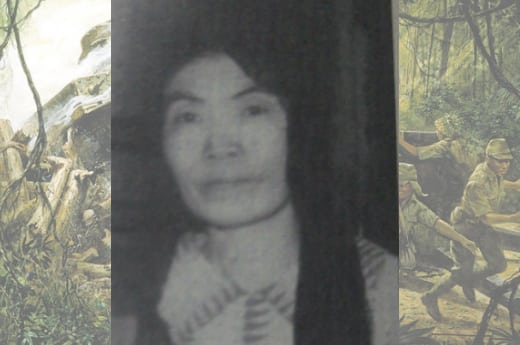
They say terrible times bring out the best and worst in people. In our history, there is no other period that could exemplify it better than the Second World War.
Filipinos threatened by hunger and death made life-changing decisions. Some remained loyal to their cause while others eventually worked as spies for the Japanese.
And then there were those like Masue Masuda-Almazan.
She had all the justifications to turn to the enemy’s side. A pure-blooded Japanese, she lived in the Philippines during the same period when her countrymen started to wreak havoc to ours.
But the darkness of WWII failed to put her good soul down. And that’s why she’s special.
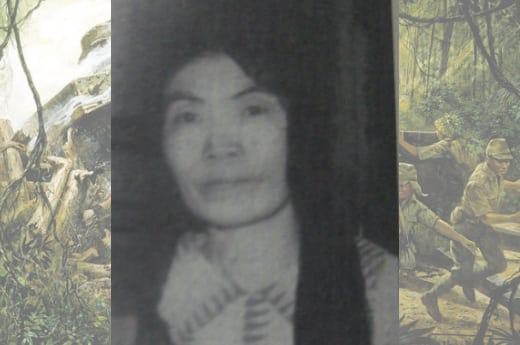
How she ended up in the Philippines was a sure act of destiny. Masue Masuda, fondly called “Masay,” was the youngest daughter of Japanese merchants Umejiro “Ekijeri” Masuda and Moyo Fucumori. In 1823, the couple emigrated from Japan to Australia in search of a greener pasture.
Also Read: The Tragic Tale of These Japanese Brothers Will Change How You Picture WWII
The Masuda family once owned a silk and pearl shop at the coastal city of Broome, 2250 kilometers northeast of Perth, Australia. The business was thriving, and for a while, the Japanese family enjoyed a comfortable life. However, everything changed when World War I broke out; tourists were few and far between and the sales of pearls plummeted.
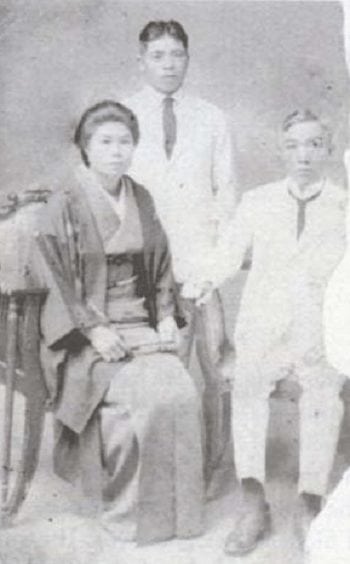
Financial constraints forced the couple to send Masay and her older sister back to Japan where they would finish their studies and live under the care of their grandmother and aunts. Moments before the sisters embarked on the journey back to their home country, their father reminded them of a message that, from then on, had shaped Masay’s life decisions:
Remember Buddha’s counsel: “the man who walks in the noble path lives in the world…and yet his heart is not defiled by worldly desires.”
In Nagasaki, the young Masay learned how to be independent and became so determined to finish her studies. She wanted to be a sensei (teacher), and that’s exactly what she became.
In 1924, the much-awaited reunion with her parents finally happened. Ekijeri and Moyo decided to return to Nagasaki after leaving Australia and operating a short-lived retail business in Manila, Philippines.
Related Article: How Cebuano Fishermen Helped Defeat the Japanese in World War II
Unfortunately, Ekijeri died a few years later. Around this time, a flock of Japanese immigrants settled down in Davao City and even established an elementary school there. Masay’s mother and sister–who married a photographer–decided to join the thriving Japanese community. Soon, Masay followed suit.
In Davao, Masay became a beloved teacher of children who was learning the Japanese language. It was also during this time when she first met her future husband–a Filipino named Vicente Almazan. Together, they had eight children, the youngest of which–Ahimoto Joseph–enlisted in the US Navy after the war.
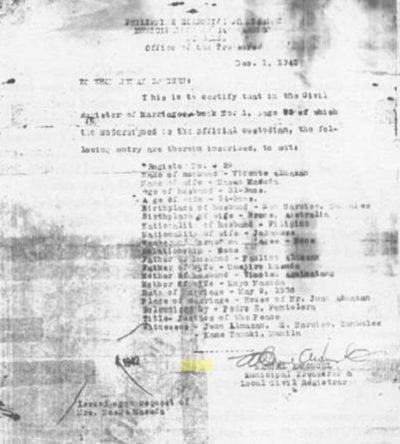
To support his young family, Vicente decided to leave Davao for his hometown–San Narciso, Zambales–where he farmed rice and other crops in a one-and-a-half hectare land he shared with his cousin.
As with the First World War, the outbreak of the second gave Masay no time to prepare for what would happen. As a Japanese national, she earned the ire of both Americans and Filipinos. Her husband became the poor victim caught in between.
Also Read: The WWII Japanese Soldier Who Hid in Philippine Jungle For 29 Years
In September of 1942, Vicente was assassinated by a Filipino guerrilla while he was descending the stairs of his house. The death of her husband traumatized Masay and her children. But instead of harboring a grudge against the Filipinos, Masay did the exact opposite. The cruelty of war became her opportunity to let her light shine.
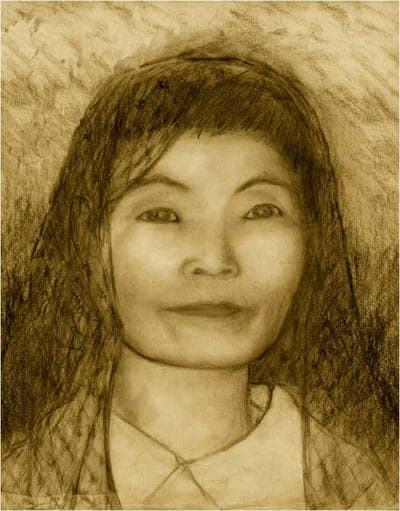
What happened during the aftermath of Vicente’s murder would have made her father, Ekijeri, extremely proud.
Masay was fluent in three languages–English, Nihongo, and Ilocano (she also knew a little bit of Tagalog). For this reason, the Kempeitai or the Japanese military police at the San Narciso garrison made her their interpreter.
It soon turned out that the Kempeitai’s lack of knowledge of the local language became the key to Masay’s heroism. She became the go-to person for the family members of Filipinos imprisoned and tortured by the Japanese. As someone well-trusted by the Kempeitai, she was able to find one compelling reason after another to prove the innocence of several prisoners.
READ: 5 Awesome Philippine Heroes Who Are Not Filipinos
In the end, Masay saved hundreds from the brink of death. One of them was the guerilla-hero Modesto Tadena Ferdivila who became inches away from being executed at the age of 21.
Another life spared from the cruelty of the Japanese was the late father of Guillermina Fontelera. The story she heard from her mother was one of love and compassion that almost ended in tragedy if it weren’t for Masay’s convincing power.
As the messenger or town crier for the underground network, her father was once arrested by Japanese guards late at night for violating the curfew. When they found a letter written in Ilocano in his pocket, they became suspicious.
With the help of Masay, however, the supposed evidence was later revealed to be nothing other than a love letter from a fiancee. The man’s life was saved in the nick of time.
This act of selflessness and bravery earned Masay the admiration of Filipinos. She never let the death of her husband or the overwhelming demands of raising eight children as a single parent discourage her.
Her daughter Presentacion saw it all:
“It would take a heart of stone not to sympathize with our mother Masay’s plight then as she continued to help rescue countless Filipinos, guerrillas and civilians alike, even when they had killed my father, our breadwinner, and even while she would leave us to the care of Manang Joyceline, our eldest, just so she could run to save people detained and tortured by the Kempei-tai.”
When the Americans landed in Leyte and the Japanese defeat became imminent, it was time for the Filipinos whose lives Masay saved to reciprocate her act of mercy. One of the grateful souls was Ricardo Aguirre who helped Masay and her children to evacuate to the barrio of Sta. Cruzan.
She followed her friend’s advice, but in so doing she had to painfully refuse the invitation of the Japanese forces to retreat to Olongapo and Subic.
We can only imagine the stress brought by such a dilemma. As much as she wanted to join her own countrymen, Masay knew that choosing that direction would also mean death for her and the children. The Japanese, after all, would rather commit suicide than suffer the shame of being captured. Masay put her family’s safety above national loyalty.
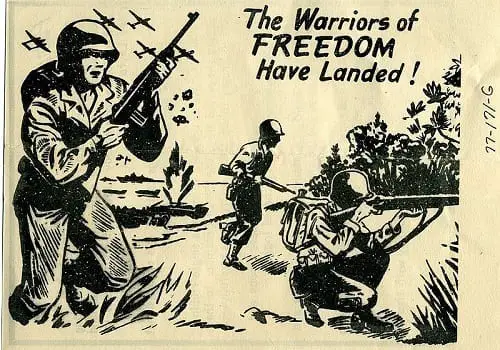
And that’s why it was with great pain when she saw one of the leaflets dropped by the Americans who were a few moments away from their ultimate victory. The words she uttered as she cried that morning of January 10, 1945 say a lot about what she had gone through:
“Ay-ay pay daguiti cailiac ken cacabsatco…matay da ngata aminen! Caasiac unay ida!” (My poor, poor brothers and countrymen! They are all going to die! Oh, I pity them!)
After the war, Masay, who was raised a Buddhist, was baptized Catholic at the San Sebastian Parish Church. Taking her new name Elizabeth Masue, the heroic Japanese teacher soon faded into oblivion.
READ: The Forgotten Story of Japanese Christians – Philippines’ First Refugees
Nanay Masay’s death on January 4, 1953, due to an advanced case of tuberculosis may have silenced her earthly body, but her legacy–the lives she saved and the people she continues to inspire–only proves that she’s a woman not worth forgetting.
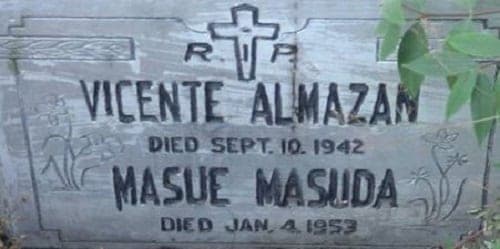
Reference
Tobia-Bulán, C. (2014). Masue: A Japanese woman of heroism and compassion. Flipside Publishing.
Written by FilipiKnow
FilipiKnow
FilipiKnow strives to ensure each article published on this website is as accurate and reliable as possible. We invite you, our reader, to take part in our mission to provide free, high-quality information for every Juan. If you think this article needs improvement, or if you have suggestions on how we can better achieve our goals, let us know by sending a message to admin at filipiknow dot net
Copyright Notice
All materials contained on this site are protected by the Republic of the Philippines copyright law and may not be reproduced, distributed, transmitted, displayed, published, or broadcast without the prior written permission of filipiknow.net or in the case of third party materials, the owner of that content. You may not alter or remove any trademark, copyright, or other notice from copies of the content. Be warned that we have already reported and helped terminate several websites and YouTube channels for blatantly stealing our content. If you wish to use filipiknow.net content for commercial purposes, such as for content syndication, etc., please contact us at legal(at)filipiknow(dot)net